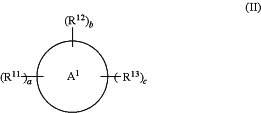| CPC G03F 7/031 (2013.01) [C07D 209/14 (2013.01); C07D 209/86 (2013.01); C08F 2/50 (2013.01); G02B 5/223 (2013.01); G03F 7/0007 (2013.01)] | 13 Claims |
|
1. An oxime ester compound comprising,
a structure represented by the following Formula (II):
 wherein,
A1 represents an aromatic ring having 6 to 20 carbon atoms;
R11 represents a group represented by the following Formula (I);
R12 represents a photoradical cleavable group containing no oxime ester group represented by the following Formula (IVα), (IVβ), (IVγ), (IVδ), (IVε), (IVζ), or (IVθ); a hydrocarbon group having 1 to 20 carbon atoms which is substituted with the photoradical cleavable group containing no oxime ester group; or a heterocycle-containing group having 2 to 20 carbon atoms which is substituted with the photoradical cleavable group containing no oxime ester group:
 in Formulae (IVα) to (IVθ),
R31 represents OR41, NR42R43, or a heterocycle-containing group having 2 to 20 carbon atoms;
R32 and R33 each represent R41 or OR41;
R32 and R33 are optionally bound together to form a ring;
R41 represents a hydrogen atom or a hydrocarbon group having 1 to 20 carbon atoms;
R42 and R43 each represent a hydrocarbon group having 1 to 20 carbon atoms;
R71 represents a hydrocarbon group having 1 to 20 carbon atoms;
R72 and R73 each represent R41 or OR41;
R34, R35, R36, R37, R38, R39, R40, Ar1, Ar2, Ar3, Ar4, Ar5, Ar6, and Ar7 each represent an aryl group having 6 to 20 carbon atoms;
v1, v2, v3, v4, v5, and v6 each represent 0 or 1;
v7 represents 1; and
* represents a bond;
R13 each independently represents a halogen atom, a nitro group, a cyano group, a hydrocarbon group having 1 to 20 carbon atoms, or a heterocycle-containing group having 2 to 20 carbon atoms;
one or more hydrogen atoms in the groups represented by R12 and R13 are optionally substituted with a halogen atom, a nitro group, a cyano group, a hydroxy group, an amino group, a carboxyl group, a methacryloyl group, an acryloyl group, an epoxy group, a vinyl group, a vinyl ether group, a mercapto group, an isocyanate group, or a heterocycle-containing group having 2 to 20 carbon atoms;
one or more methylene groups in the groups represented by R12 are optionally substituted with —O—, —CO—, —COO—, —OCO—, —NR14—, —NR14CO—, —CS—, —SO2—, —SCO—, —COS—, —OCS—, or CSO—, provided that oxygen atoms are not arranged adjacent to one another;
one or more methylene groups in the groups represented by R13 are optionally substituted with —O—, —CO—, —COO—, —OCO—, —NR14—, —NR14CO—, —S—, —CS—, —SO2—, —SCO—, —COS—, —OCS—, or CSO—, provided that oxygen atoms are not arranged adjacent to one another;
R14 represents a hydrogen atom or a hydrocarbon group having 1 to 20 carbon atoms;
a represents an integer of 1 to 20 and, when a is an integer of 2 or larger, plural R11s are optionally the same or different;
b represents an integer of 1 to 20 and, when b is an integer of 2 or larger, plural R12s are optionally the same or different;
c represents an integer of 0 to 20 and, when c is an integer of 2 or larger, plural R13s are optionally the same or different; and
(a+b+c) is 20 or less;
 wherein,
R1 and R2 each independently represent a hydrogen atom, a halogen atom, a nitro group, a cyano group, a hydrocarbon group having 1 to 20 carbon atoms, or a heterocycle-containing group having 2 to 20 carbon atoms;
one or more hydrogen atoms in the groups represented by R1 and R2 are optionally substituted with a halogen atom, a nitro group, a cyano group, a hydroxy group, an amino group, a carboxyl group, a methacryloyl group, an acryloyl group, an epoxy group, a vinyl group, a vinyl ether group, a mercapto group, an isocyanate group, or a heterocycle-containing group having 2 to 20 carbon atoms;
one or more methylene groups in the groups represented by R1 and R2 are optionally substituted with —O—, —CO—, —COO—, —OCO—, —NR3—, —NR3CO—, —S—, —CS—, —SO2—, —SCO—, —COS—, —OCS—, or CSO—, provided that oxygen atoms are not arranged adjacent to one another;
R3 represents a hydrogen atom or a hydrocarbon group having 1 to 20 carbon atoms;
n represents 0 or 1; and
* represents a bond.
|